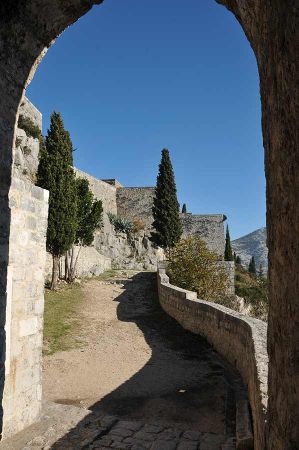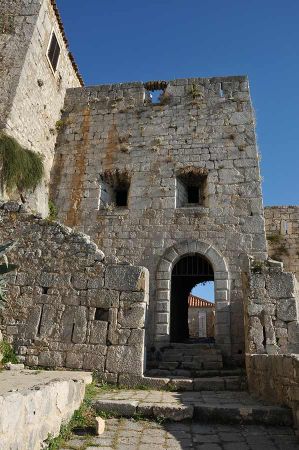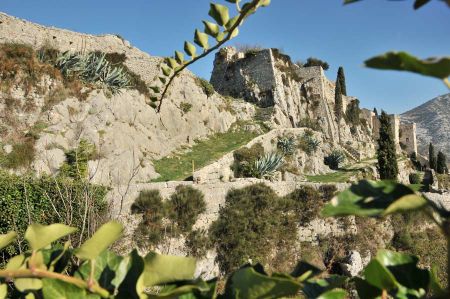The Klis Fortress - bulwark to the Split peninsula
- Written by Portal Editor
The first point of our sightseeing program was scheduled early the next morning, which was to lead to the castle and fortress of Klis. The fortress has always played a crucial role in the eventful history of Split and the surrounding area, as it was the first place to pass if you wanted to get from the hinterland to the coast.
This was true for both the Illyrians and later the Romans, because from here the road from Salona to the interior could be easily monitored. Later, when it was of little importance during the migration period, Klis Castle was rebuilt in the 9th century by the Croatian Prince Trpimir I. In the following centuries, the place repeatedly served as a residence for the Croatian kings.
Klis owned by the Croatian noble family Šubić

In the 13th century, Klis came into the possession of the Croatian noble family Šubić. As the family with Mladen III. Šubić died out in 1354, the Bosnian Ban Tyrtko was supposed to take possession of the fortress for the Hungarian king. He was preceded by the Serbian Tsar Stephan Dušan, whose troops occupied Klis in 1355. After Dušan's death in the same year, Klis was alternately under Hungarian and Bosnian rule, but was always given as a fief to a Croatian noble.
Ottoman Empire in 1463 Bosnia

Once you entered the first gate of the fortress, it became clear that the location of this castle complex was considered almost impregnable. Two more gates followed, with things going steadily uphill on a narrow gradient. The floor plan is a very narrow but elongated complex, which is a maximum of 30 meters wide. Very easy to defend if there are enough provisions available. Robi also had a lot of details about the Ottomans and often jokingly talked to Seher about the "enemies", of which she was one. In short, the visit to the fortress, as well as all the other short stays later, turned out to be absolutely informative without the flow of information ever becoming too much. But more on that later.
In 1522 the Ottomans tried to take the fortress of Klis above Spalatos, which was repelled with the support of Archbishop Tommaso de Nigris (Toma Nigris). The Spalatin humanists Marcus Marulus Spalatensis (Marko Marulić/Marco Marulo) and Franciscus Natalis (Franjo Božičević Natalis) underpinned the anti-Ottoman sentiment in the city. Petar Kružić (Peter Krusitsch), captain of the Klis Fortress, had fended off Ottoman attacks for more than 20 years when he fell in 1537 in the course of the Fourth Ottoman-Venetian War (1537–1540) and with him the fortress, which was henceforth known as Ottoman served as an outpost for attacks on Spalato.
The most important trade route ran from Split via Klis to Sarajevo
The Ottomans built a mosque and made Klis the centre of a sanjak. From Klis, Ottoman troops threatened Venetian Dalmatia for a long time. In 1596 the Venetians succeeded in conquering Klis for the first time; However, they had to vacate the fortress again after a short time. Despite the often-hostile relationship between the Republic of St. Mark and the Ottomans, trade between the Dalmatian coast and the interior of the Balkans was never interrupted for long. The most important trade route ran from Split via Klis to Sarajevo. Both Dalmatian and Turkish merchants travelled this route with donkey caravans. In 1648, the Venetians were able to conquer Klis again during the War of Candia under the command of Leonardo Foscolo. While Crete had to be abandoned at the same time, the Republic of Klis was preserved under the peace treaty of 1669.
Fortress builder Alessandra Maglio built mighty bastions
During the first tour we had already received a rough overview of the historical processes, for which we were very grateful. People increasingly had the feeling that they could better identify the connections between the historical buildings, the natural landscape and their inhabitants. From now on it should be about antiquity and what could still emerge in the region around Split.
Please read as well:
Fendt Caravan - First contact at Caravan Salon Düsseldorf
Porta Caesarea - a city gate of Salona
https://www.alaturka.info/en/croatia/split/6299-the-klis-fortress-bulwark-to-the-split-peninsula/amp#sigProId47f96e8910
